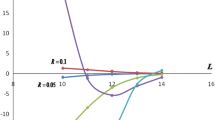Abstract
By the use of complete orthonormal sets of ψα-ETOs (α=1, 0, −1, −2, ...) introduced by the author, new addition theorems are derived for STOs and arbitrary central and noncentral interaction potentials (CIPs and NCIPs). The expansion coefficients in these addition theorems are expressed through the Gaunt and Gegenbauer coefficients. Using the addition theorems obtained for STOs and potentials, general formulae in terms of three-center overlap integrals are established for the multicenter t-electron integrals of CIPs and NCIPs that arise in the solution of the N-electron atomic and molecular problem (2≤t≤N) when a Hylleraas approximation in Hartree–Fock–Roothaan theory is employed. With the help of expansion formulae for translation of STOs, the three-center overlap integrals are expressed through the two-center overlap integrals. The formulae obtained are valid for arbitrary quantum numbers, screening constants and location of orbitals.
Similar content being viewed by others
References
Slater JC (1960) Quantum theory of atomic structure, vol 2. McGraw-Hill, New York, pp 31–50
Hylleraas EA (1928) Z Phys 48:469–494
(a) Hylleraas EA (1929) Z Phys 54:347–366; (b) Hylleraas EA (1930) Z Phys 60:624–636; (c) Hylleraas EA (1930) Z Phys 65:209–216
Boys SF (1950) Proc R Soc London Ser A 201:125–145
(a) Löwdin PO (1955) Phys Rev 97:1474–1491; (b) Löwdin PO (1960) Rev Mod Phys 32:328–346
Szasz L (1962) Phys Rev 126:169–178
Sims JS, Hagstrom SA (2002) Int J Quantum Chem 90:1600–1609
James HM, Coolidge AS (1933) J Chem Phys 1:825–837
Kolos W, Roothaan CCJ (1960) Rev Mod Phys 32:205–227
Kolos W, Wolniewicz L (1964) J Chem Phys 41:3663–3672
Lüchow A, Kleindienst H (1993) Int J Quantum Chem 45:445–470
King FW (1993) J Chem Phys 99:3622–3628
Porras I, King FW (1994) Phys Rev A 49:1637–1645
Guseinov II (1998) J Mol Struct (Theochem) 422:75–78
Guseinov II (2002) Int J Quantum Chem 90:980–985
Guseinov II (2002) Int J Quantum Chem 90:114–118
Guseinov II (2003) J Mol Model, in press
Guseinov II (1970) J Phys B 3:1399–1412
Author information
Authors and Affiliations
Corresponding author
Appendix
Appendix
As can be seen from Eq. (23), the multicenter t-electron integrals are expressed through the following basic three-center one-electron integrals over STOs:
where
and
Here, \( {R_{{N_{k} }} (z_{k} ,r)\,\,\,{\rm{and}}\,\,\,S_{{L_{k} M_{k} }} (\theta ,\varphi )} \) are the radial parts of normalized STOs and the spherical harmonics, respectively. See [18] for the exact definition of the Gaunt coefficients C L│M│ and the quantities \( A_{mm'}^M \). We notice that, Eq. (28) can easily be derived by the use of the following expansion relation for the product of two spherical harmonics both with one and the same center [18]:
Inserting Eqs. (26) and (28) into the integral in Eq. (25) leads to the three-center overlap integrals
Using the expansion formulae for electron charge densities (see Eq. (19) of [15]), the three-center overlap integrals [Eq. (31)] can be expressed through the two-center overlap integrals:
where \( z = \zeta + \zeta ',\;S_{\mu \nu \sigma ,\mu '\nu '\sigma '}^{} (z,z';\vec R_{ab} ) \equiv S_{\mu \nu \sigma ,\mu '\nu '\sigma '}^{ab} (z,z')\,\,{\rm{and}}\,\,W^{\alpha N} \) is the two-center charge density expansion coefficient. Thus, the basic three-center one-electron integrals (Eq. 25) are determined solely from the two-center overlap integrals.
The results of calculation for the two-center two-electron integrals of central interaction potential f 000(0, r 21)=1/r 21 obtained with a Pentium III 800 MHz computer (using TURBO Pascal 7.0) are shown in Table 1. The comparative values obtained from the expansions in terms of different complete orthonormal sets of ψα-ETOs are shown in this table. As can be seen from the table, the computation time and accuracy of the computer results for different expansion formulae obtained from ψ0-ETOs, ψ1-ETOs and ψ–1-ETOs are satisfactory. Work is in progress for the computation of multicenter multielectron integrals of central and noncentral interaction potentials over STOs based on the formulae given in this work.
Rights and permissions
About this article
Cite this article
Guseinov, I. Addition theorems for Slater-type orbitals and their application to multicenter multielectron integrals of central and noncentral interaction potentials. J Mol Model 9, 190–194 (2003). https://doi.org/10.1007/s00894-003-0134-0
Received:
Accepted:
Published:
Issue Date:
DOI: https://doi.org/10.1007/s00894-003-0134-0



